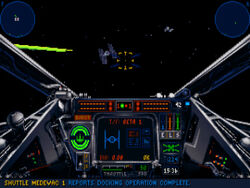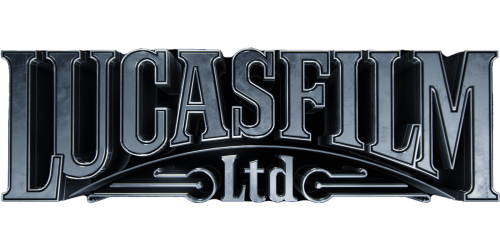| Star Wars: X-Wing | |
|---|---|

| |
| Developed by: | LucasArts |
| Published by: | LucasArts |
| Genre(s): | Space simulation |
Star Wars: X-Wing is the first LucasArts DOS computer game set in the Star Wars universe, as well as the lead title in the X-Wing combat flight simulator game series. The player's character flies starfighters, including the eponymous X-wing, for the Rebel Alliance as part of a narrative that precedes and parallels the events of Star Wars Episode IV: A New Hope.
Designed by Lawrence Holland and Edward Kilham's Totally Games for LucasArts, X-Wing was one of the first games to use 3D polygon graphics for spaceships and the first non-adventure game to use the iMUSE music system. The game was updated and re-released several times, and was followed by three sequels. X-Wing was a best-seller and received critical acclaim.
Plot[]
Players assume the role of a Rebel pilot fighting the Galactic Empire before and during the climactic battle of the first Star Wars film. The story consists of three tours of duty of 12 to 14 operations each; although the tours can be played out of order, operations within each tour are played linearly. Briefings, cutscenes, and in-flight messages advance the plot. Additionally, a limited edition of the game came packaged with a 96-page novella, The Farlander Papers by Rusel DeMaria, that provides story information. The novella, later made part of Prima Publishing's strategy guide, presents a pilot name Keyan Farlander as the player's character for most of the operations.[1]
Progress through the game depends on fulfilling each operation's primary objectives; if the player fails an operation, he or she can attempt it again. The initial game's storyline concludes with the player flying as Luke Skywalker in his attack against the Death Star. Two expansion packs extend the story beyond the events in A New Hope, up to the establishment of the Rebel base depicted at the beginning of Star Wars Episode V: The Empire Strikes Back.
Gameplay[]

A TIE fighter fires past the player's X-wing during the fourth operation of the first tour of duty. The TIE fighter model consists of 3D polygons; most previous simulators used bitmapped images instead. The bars over the "ELS" text (right-center) indicate the player's power allocations to engines, lasers, and shields.
After choosing a pilot file to play with, the player is presented with a "concourse" aboard the Mon Calamari Star Cruiser Independence. From here, the player can choose between flying in a proving ground, historical simulator, or tour of duty. In the proving ground, the player maneuvers a starfighter through a series of gates within a time limit. The historical simulator depicts missions not tied to the main storyline. The game's plot is advanced through tour of duty operations. When the player completes a tour of duty operation, it becomes available for replay in the historical simulator. In addition to the flight options, players can access a technical room that shows images of the game's spacecraft, and a film room for reviewing recorded flight data.
As a space flight simulator game, X-Wing puts the player at the controls of various starfighters in space combat against enemy spacecraft. Drawing some influence from Star Raiders (1979),[2] the game is played in first-person from inside the cockpit. The initial game offered pilotable A-wing, X-wing, and Y-wing craft; the B-Wing expansion adds the B-wing as a playable vehicle.
All flight takes place in space; the player does not encounter gravity or atmospheric effects. The starfighters are equipped with recharging laser weapons and limited warheads. The player controls power allocation between lasers, deflector shields, and engines. Charging the lasers and shields slows the player's craft, giving effective power management an important role in gameplay.[3] The player can toggle the firing mode (separate or linked) of each weapon type, and balance the shields forward, aft, or evenly.
Missions types include dogfights, escorting or disabling other vessels, convoy attacks, and strikes on capital ships. During missions, the player can send orders to friendly craft. In the original floppy disk version, the player can assign other saved pilot profiles to be his or her wingman; the higher the rank of the saved profile, the better the computer-controlled wingman would perform. This was removed from subsequent releases.
The player earns points for each tour of duty mission by completing objectives and destroying enemy spacecraft. Medals and ranks are awarded for campaign progress; if the player dies in combat, his or her score and awards are lost, but campaign progress is preserved.
Development[]
Until 1992, Brøderbund held the license for Star Wars computer games.[4] When the license reverted to LucasArts, designer Lawrence Holland decided to develop a Star Wars game that took advantage of his prior experience developing World War II air combat simulators.[4] X-Wing's game engine was one of the first to use higher-detailed 3D polygonal graphics, rather than bitmaps.[5]
The game's MIDI musical score includes pieces from John Williams' Star Wars score in addition to original compositions. X-Wing is the first non-adventure game to use the iMUSE Interactive MUsic Streaming Engine, although the system's level of interactivity is reduced from previous iterations. For X-Wing, iMUSE provides musical cues in response to in-game events, such as the arrival of friendly or hostile ships. Music designers Michael Land, Clint Bajakian, and Peter McConnell used familiar elements of Williams' music to create these cues. The musical cues were designed to blend seamlessly with the rest of the in-game music soundtrack.[6]
Release[]

TIE bombers fly toward a Mon Calamari Star Cruiser in the 1998 release. This version updated the game engine to that used by X-Wing vs. TIE Fighter, introducing 3D-accelerated graphics and higher-resolution cockpits. The game also replaced the dynamic MIDI soundtrack with looped audio of John Williams' orchestral Star Wars music.
X-Wing was originally released on floppy disks in February 1993. Later that year, LucasArts released the Imperial Pursuit and B-Wing expansion packs on a floppy disk.
LucasArts released the TIE Fighter space combat simulator in 1994. That same year, it released the Collector's CD-ROM Edition of X-Wing. This edition runs on the TIE Fighter game engine, itself based on the X-Wing engine. The newer engine supports Gouraud shading and other rendering enhancements. The Collector's CD-ROM Edition includes the base game and both expansions. It also includes some adjustments to missions, redesigned cutscenes, bonus missions, and voiceovers for the mission briefings and in-game radio messages. Erik Bauersfeld, who voiced Admiral Ackbar in Star Wars Episode VI: Return of the Jedi provided the voice for Ackbar in the game. Additionally, Clive Revill, who voiced Emperor Palpatine in The Empire Strikes Back (pre-2004 version), portrayed Admiral Dodonna. Owners of a floppy disk version could send payment and the back of their instruction manual to LucasArts and receive a special "Gold Edition" of the CD-ROM version, which included the game on a golden CD-ROM and a free gift.
In 1998, LucasArts released the X-Wing Collector Series Edition. This product again changed the game engine, this time to the engine behind X-Wing vs. TIE Fighter. This update added 3D hardware acceleration and texture mapping to the game engine, and further changed some of the visuals before and during operation briefings. The game was designed to run under Windows 9x rather than DOS. Additionally, the MIDI-based iMUSE soundtrack was replaced with looping Red Book audio recordings of the Star Wars score.
Reception[]
X-Wing, which "skillfully captured the feel" of the Star Wars films,[4] was a best-seller in 1993.[5] Compute! said the game succeeds at being "the first authentic space-combat simulator", comparing it favorably to the contemporaneous Wing Commander.[7] Compute! called the game's rigid structure, leaving no margin for error, "controversial".[7]
The game received awards for "Simulation of the Year" from Computer Gaming World, "Best Simulation of 1993" from Computer Game Review, and "Best Game of 1993" from Electronic Entertainment.[8] In 1994, X-Wing won the Origins Award for "Best Fantasy or Science Fiction Computer Game of 1993".[9] GameSpot called X-Wing "one of the best" Star Wars games and an example of how immersive a game can be; they specifically praised the game's graphics, attention to detail, audio, and story.[10] The Keyan Farlander character later appears in two New Jedi Order books, and Hasbro in 2008 created a Keyan Farlander action figure.[1]
See also[]
- List of Star Wars starfighters
- List of Star Wars spacecraft
References[]
- ↑ 1.0 1.1 Hidalgo, Pablo (2012). The Essential Reader's Companion. Del Rey Books, 196. ISBN 978-0-345-51119-5. Retrieved on April 23, 2013.
- ↑ Dillon, Roberto (2011). "Games That Pushed Boundaries I", The Golden Age of Video Games: The Birth of a Multi-billion Dollar Industry. Taylor and Francis Group, LLC, 60. ISBN 978-1-4398-7323-6. Retrieved on April 23, 2013.
- ↑ Retro Game Review: X-Wing (August 26, 2011). Retrieved on April 24, 2013.
- ↑ 4.0 4.1 4.2 Bakie, Rober T. (2010). "A Brief History of Video Games", Introduction to Game Development: Second Edition, 2nd, Cengage Learning, 34. ISBN 978-1-58450-679-9. Retrieved on April 23, 2013.
- ↑ 5.0 5.1 Cite error: Invalid
<ref>tag; no text was provided for refs namedlucasartshistory - ↑ Strank, Willem (2013). "The Legacy of iMuse: Interactive Video Game Music in the 1990s", Music and Game: Perspectives on a Popular Alliance. Berlin: Springer Fachmedien Wiesbaden, 87-88. ISBN 978-3-531-17409-9. Retrieved on April 23, 2013.
- ↑ 7.0 7.1 Template:Cite magazine
- ↑ Fact Sheet. Totally Games. Retrieved on April 23, 2013.
- ↑ 1993 - Academy of Adventure Gaming Arts and Design. originsgamefair.com. Archived from the original on May 7, 2008. Retrieved on June 30, 2008.
- ↑ GameSpot's History of Star Wars Games. CBS Interactive. Retrieved on April 23, 2013.
External links[]
- Retro Now Playing - Star Wars: X-wing at GameSpot
- Star Wars: X-wing on Wookieepedia: a Star Wars wiki
- Star Wars: X-Wing at MobyGames
| This page uses content from the English Wikipedia. The original article was at Star Wars: X-Wing. The list of authors can be seen in the page history. As with Lucasfilm Wiki, the text of Wikipedia is available under the GNU Free Documentation License. |
